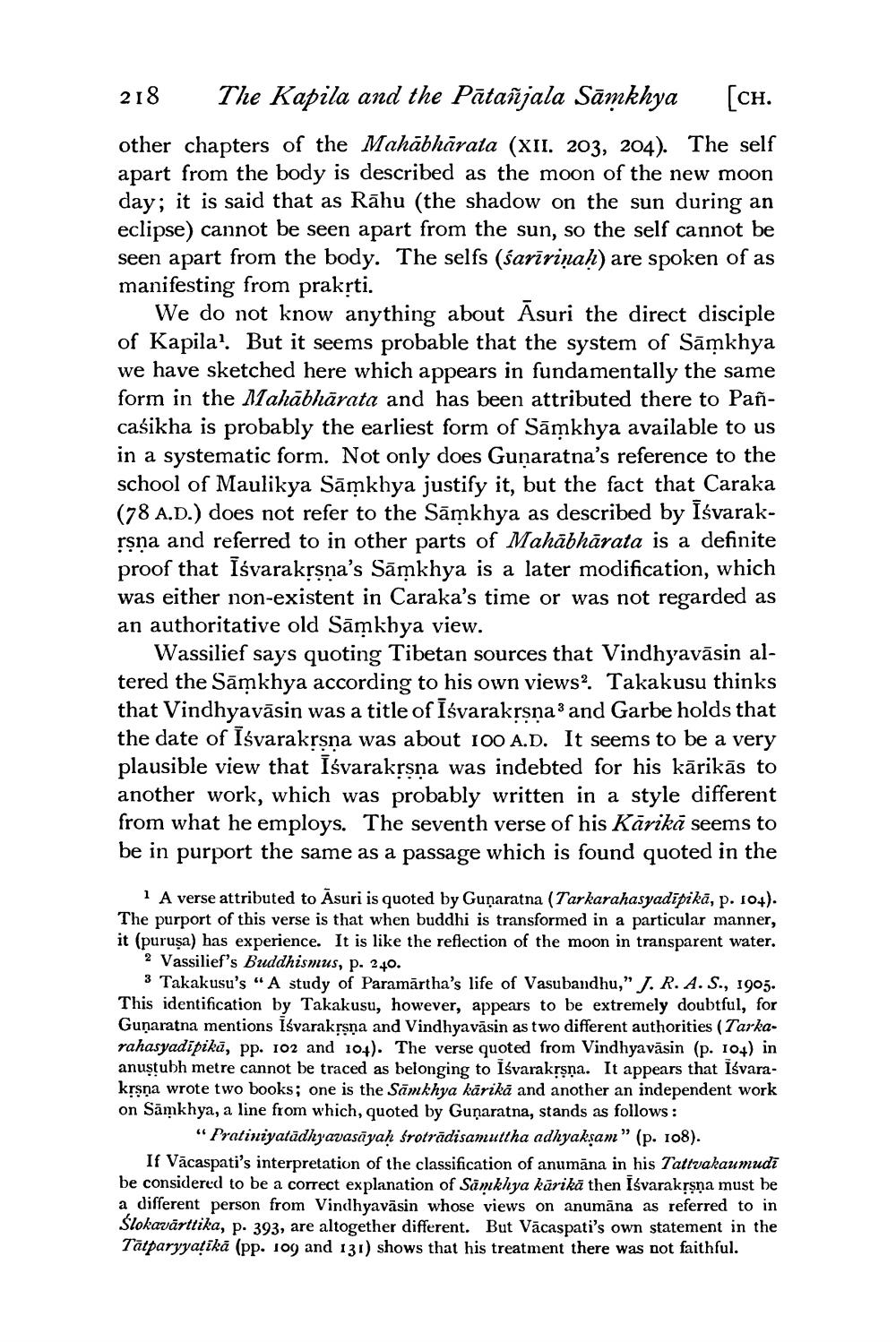________________
218
The Kapila and the Patanjala Samkhya
[CH.
other chapters of the Mahabharata (XII. 203, 204). The self apart from the body is described as the moon of the new moon day; it is said that as Rāhu (the shadow on the sun during an eclipse) cannot be seen apart from the sun, so the self cannot be seen apart from the body. The selfs (śarīriņaḥ) are spoken of as manifesting from prakṛti.
We do not know anything about Asuri the direct disciple of Kapila'. But it seems probable that the system of Samkhya we have sketched here which appears in fundamentally the same form in the Mahabharata and has been attributed there to Рañcasikha is probably the earliest form of Samkhya available to us in a systematic form. Not only does Gunaratna's reference to the school of Maulikya Sāmkhya justify it, but the fact that Caraka (78 A.D.) does not refer to the Samkhya as described by Iśvarakṛṣṇa and referred to in other parts of Mahābhārata is a definite proof that Iśvarakṛṣṇa's Sāmkhya is a later modification, which was either non-existent in Caraka's time or was not regarded as an authoritative old Samkhya view.
Wassilief says quoting Tibetan sources that Vindhyavāsin altered the Samkhya according to his own views2. Takakusu thinks that Vindhyavasin was a title of Īśvarakṛṣṇa3 and Garbe holds that the date of Isvarakṛṣṇa was about 100 A.D. It seems to be a very plausible view that Iśvarakṛṣṇa was indebted for his kārikās to another work, which was probably written in a style different from what he employs. The seventh verse of his Kārikā seems to be in purport the same as a passage which is found quoted in the
1 A verse attributed to Asuri is quoted by Gunaratna (Tarkarahasyadipikā, p. 104). The purport of this verse is that when buddhi is transformed in a particular manner, it (puruşa) has experience. It is like the reflection of the moon in transparent water. 2 Vassilief's Buddhismus, p. 240.
3 Takakusu's "A study of Paramartha's life of Vasubandhu," J. R. A. S., 1905. This identification by Takakusu, however, appears to be extremely doubtful, for Gunaratna mentions Iśvarakṛṣṇa and Vindhyavasin as two different authorities (Tarkarahasyadipikā, pp. 102 and 104). The verse quoted from Vindhyavasin (p. 104) in anuştubh metre cannot be traced as belonging to Isvarakṛṣṇa. It appears that Iśvarakṛṣṇa wrote two books; one is the Sāmkhya kārikā and another an independent work on Samkhya, a line from which, quoted by Gunaratna, stands as follows:
"Pratiniyatadhyavasayaḥ śrotrādisamuttha adhyakṣam" (p. 108).
If Vacaspati's interpretation of the classification of anumāna in his Tattvakaumudi be considered to be a correct explanation of Samkhya karika then Iśvarakṛṣṇa must be a different person from Vindhyavasin whose views on anumana as referred to in Slokavārttika, p. 393, are altogether different. But Vacaspati's own statement in the Tatparyyatika (pp. 109 and 131) shows that his treatment there was not faithful.




